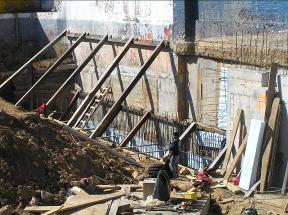|
UNDERPINNING |
|
Generally soils become firmer with depth however, occasionally, there is a loose layer beneath a medium dense sand which will not support a spread foundation. In this case on 3rd Street in Brooklyn, NY it was necessary to pile support the underpinning of the building. The piles were drilled into place and the main body of the underpinning pits were individually cast around each pile to within inches of the building foundation. Once the concrete was cured the space between the pile support underpin and the foundation was dry packed tightly to prevent any settlement due to shrinkage. |

|
Horatio St - NY,NY Standard approach pit and dry packing requires proper design, careful sequencing and installation to prevent settlement of the foundation or adjacent slabs, utilities, etc. Regular inspections are essential to verify that the work is performed properly. |

|
Nostrand Ave. Brooklyn, NY Lateral soil loads can cause failure of underpinning before the new walls can be poured. This project required two separate rows of braces to support the 17 feet deep excavation. Size and location of the bracing is highly dependent upon soil strength, excavation depth and weight of the adjacent building. |






|
Temporary cross bracing of underpinning. |
|
Underpinning rebars embedded for lateral support. |